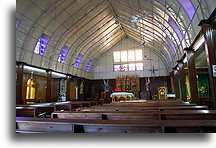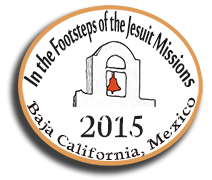Church by Gustave Eiffel
November 18



In the morning, we continued our journey through the desert, until we reached the highway 1. On that day, we wanted to see more rock art. Well-known paintings of the Sierra de San Francisco are on the UNESCO World Heritage list. When we reached the place, it turned out that a high fence surrounds the rock shelter and the gate is closed. For those who want to see this place they must to ride a bumpy road to the village of San Francisco. So we did. One of the locals was in the charge of entrance fees to all prehistoric sites in the area. We bought tickets from him and for an additional fee we were assigned a guide that will open the gate. The rules here were that all the sites with paintings could be visited only when a local guide is present. Therefore, we took an elderly vaquero or cowboy to the car and drove back to see the art.


Unfortunately, we were not impressed this time. Rock paintings were covered with dust, and in most places, they were hard to recognize. That must be consequences of the location, next to the dirt road. In addition, forced to walk on wooden platforms with railings, we felt like a school excursion led by the hand. Guide was not very helpful; he took the money, but said nothing about the murals. We were not quite excited about this place and left without regret.


Our next stop was San Ignacio, a small town, which turned out to be a success in the missionary efforts initiated by the Jesuits. This place had a great location with almost unlimited resources of water. Over the years, a village of the same name was built around Mission San Ignacio. Before the arrival of missionaries in 1728, this was simply a desert oasis known among the local Cochimí Indians as Kadakaamán or stream of reeds.



Decimated by epidemics and diseases of the Old World, the native population rapidly decreased and by 1840 completely disappeared from the face of the earth. In a little more than 100 years, Misión San Ignacio Kadakaamán lost its primary objective, and the missionaries left the place. The Dominicans who came after the Jesuits completed the present church building. Today it is the parish church. The temple has a Latin cross plan, and is roofed with vaults and dome. Gilded wooden altar was brought from Mexico City in the end of the 18th century.



In the evening, we arrived at Santa Rosalia, a mining town on the shores of the Gulf of California. It is an ugly place, only the old French quarter is worth a short visit. We stopped there to see the Iglesia de Santa Barbara, the church building designed by Gustave Eiffel, the same Eiffel who designed the famous tower in Paris and built Statue of Liberty in New York City. The French architect came up with the idea of the folding churches that could be sent quickly and easily to overseas colonies. He presented his first church based on this idea at the exhibition in Paris in 1889. After the exhibition, the steel structure was dismantled and moved to Brussels, Belgium where the mining company from San Igancio, Mexico acquired it. The church in pieces was shipped by sea and assembled here in 1897. The church is made of stamped steel sheets, mainly squares. When assembled, the roof from the inside resembles a capsized boat. Eiffels church is an ugly steel structure, but is based on the unique and clever idea.



We heard about the old bakery in the city, which reportedly sold baguettes baked based on a 120-year-old traditional recipe. Do not bother! Almost everything they sell is a sweet bread that has nothing to do with the French tradition. The prices here are 10 times higher than in other stores. It is a rip-off. All the specialties we bought, turned out to be not tasty. We thought about throwing them away, but fortunately, the homeless and emaciated dog showed up a few days later and ate everything.









